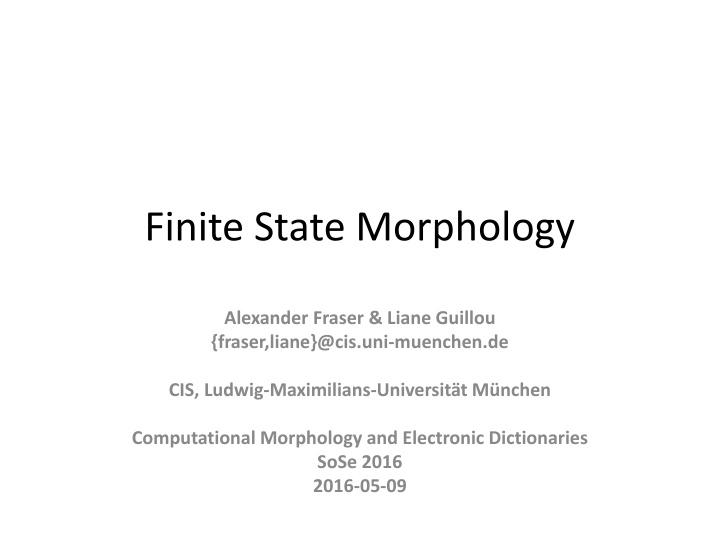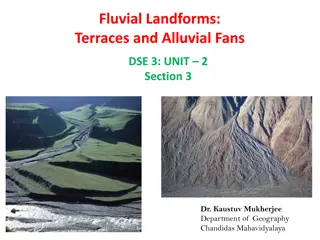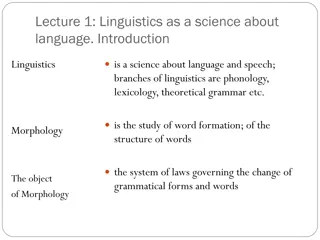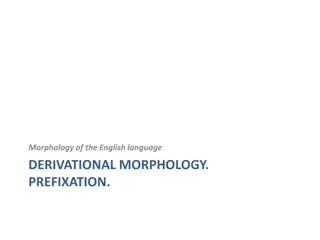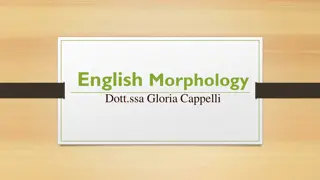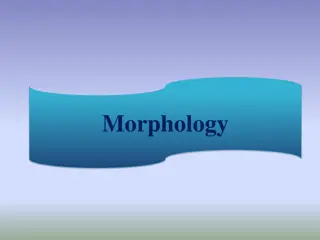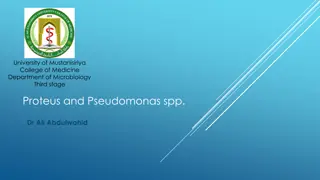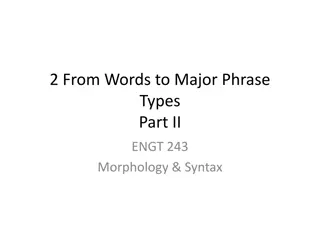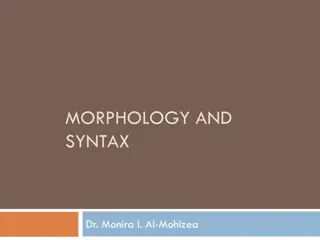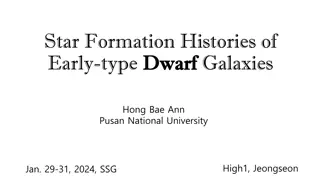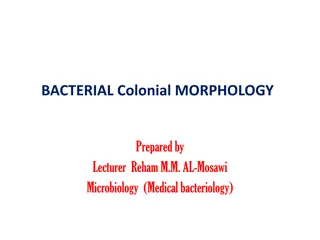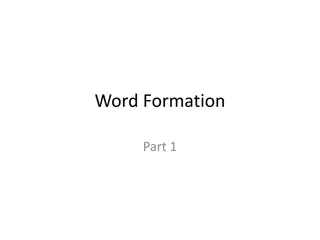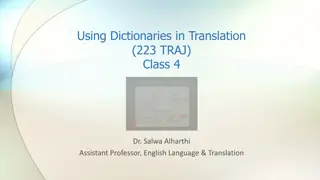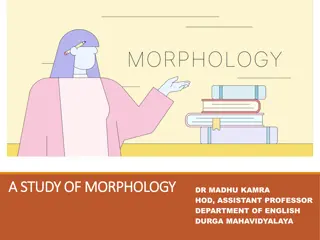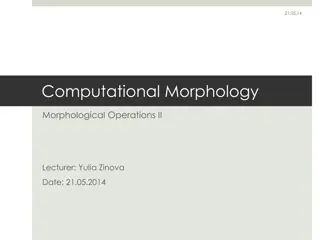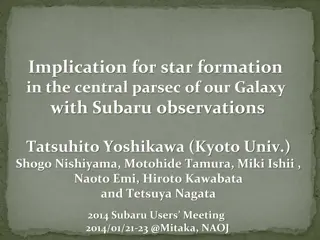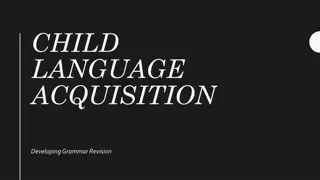Computational Morphology: Exploring Word Formation Processes
This content delves into computational morphology, analyzing word forms, affixes, and morphological units. It covers inflection, derivation, and compound word formation processes in linguistics.
Download Presentation

Please find below an Image/Link to download the presentation.
The content on the website is provided AS IS for your information and personal use only. It may not be sold, licensed, or shared on other websites without obtaining consent from the author.If you encounter any issues during the download, it is possible that the publisher has removed the file from their server.
You are allowed to download the files provided on this website for personal or commercial use, subject to the condition that they are used lawfully. All files are the property of their respective owners.
The content on the website is provided AS IS for your information and personal use only. It may not be sold, licensed, or shared on other websites without obtaining consent from the author.
E N D
Presentation Transcript
Finite State Morphology Alexander Fraser & Liane Guillou {fraser,liane}@cis.uni-muenchen.de CIS, Ludwig-Maximilians-Universit t M nchen Computational Morphology and Electronic Dictionaries SoSe 2016 2016-05-09
Outline Today we will cover finite state morphology more formally We'll review concepts from the first lecture and from the exercises And define operations in finite state more formally We will then show how to convert regular expressions to finite state automata
Exercise Please check the website tomorrow for the exercise location (may also be cancelled)
Credits Credits: Slides mostly adapted from: Finite State Morphology Helmut Schmid U. T bingen - Summer Semester 2015 Thanks also to Kemal Oflazer and Lauri Kartunnen
Review: Computational Morphology examines word formations processes provides analyses of word forms such as Tarifverhandlungen: Tarif<NN>verhandeln<V>ung<SUFF><+NN><Fem><Nom><Pl> splits word forms into roots and affixes provides information on part-of-speech such as NN, V canonical forms such as verhandeln morphosyntactic properties such as Fem, Nom, Pl
Terminology word form word as it appears in a running text: weitergehst lemma citation as listed in a dictionary: weitergehen stem part of a word to which derivational of inflectional affixes are attached: weitergeh root stem which cannot be further analysed: geh morpheme smallest morphological units (stems, affixes): weiter, geh, en
Word Formation Processes Inflection Derivation Compounding
Inflection modifies a word in order to express different grammatical categories such as tense, mood, voice, aspect, person, number, gender, case verbal inflection: conjugation nominal inflection: declension computers usually realised by prefixation suffixation circumfixation ge+hab+t infixation auf+zu+machen (not a perfect example) reduplication: orang+orang (plural of man in Indonesian) walks, walked, walking
Derivation creates new words Examples: un+translat+abil+ity piti+less-ness changes the part-of-speech and/or meaning of the word adds prefixes, suffixes, circumfixes conversion: changes the part-of-speech without modifying the word book (N) book (V) leid(en) (V) Leid (N) templatic morphology in Arabic ktb + CVCCVC + (a,a) -> kattab (write)
Compounding creates new words by combining several stems example: Donau-dampf-schiff-fahrts-gesellschaft very productive in German affixoid compounding process that turns into a derivation process Gas+werk, St ck+werk, Laub+werk schul+frei, schulter+frei, schulden+frei no absolute boundary between compounding and derivation
Classification of Languages isolating: Chinese, Vietnamese little or no derivation and inflection analytic: Chinese, English little or no inflection synthetic agglutinative: Finnish, Turkish, Hungarian, Swahili morphemes are concatenated with little modification each affix usually encodes a single feature fusional (inflecting): Sanskrit, Latin, Russian, German inflectional affixes often encode a feature bundle: les+e (1 sg pres)
Productivity productive process new word forms can easily be created use+less, hope+less, point+less, beard+less unproductive process: morphological process which is no longer active streng+th, warm+th, dep+th
Morphotactics Which morphemes can be arranged in which order? translat+abil+ity *translat+ity+abil translat+able *translat+able+ity (Allomorphs able-abil)
Orthographic/Phonological Rules How is a morpheme realised in a certain context? city+s cities bake+ing baking (e-elision) crash+s crashes beg+ing begging ad+simil+ate assimilate ip+lEr ipler (e-epenthesis) (gemination) (assimilation) (vowel harmony) k z+lEr k zlar
Morphological Ambiguity leaves hanged hung leaf+N+pl leave+N+pl leave+V+3+sg hang+V+past
Ingredients of a Morph. Analyser List of roots with part-of-speech List of derivational affixes morphotactic rules orthographic (phonological) rules
Computational Morphology analyses and/or generates word forms analysis Abteilungen Abteilung<NN><Fem><Nom><Pl> Abteilung<NN><Fem><Acc><Pl> ab<VPART>teilen<V>ung<NNSuff><Fem><Acc><Pl> Abtei<NN> Lunge<NN><Fem><Nom><Pl> Abt<NN> Ei<NN> Lunge<NN><Fem><Nom><Pl> Abt<NN> eilen<V> ung<NNSuff><Fem><Nom><Pl> generation sichern<+V><1><Sg><Pres><Ind> sichere, sichre
Implementation using a mapping table works reasonably well for languages such as English, Chinese algorithmic more suitable for languages with complex morphology such as Turkish or Czech finite state transducers simple, well understood, efficient, bidirectional (analysis & generation)
Short History 1968 Chomsky & Halle propose ordered context-sensitive rewrite rules x y / w _ z (replace x by y in the context w z) C. Douglas Johnson discovers that ordered rewrite rules can be implemented with a cascade of FSTs if the rules are never applied to their own output Sch tzenberger proved that 2 sequential transducers (where the output of the first forms the input of the second) can be replaced by a single transducer. Kaplan & Kay rediscover the findings of Johnson and Sch tzenberger Kimmo Koskenniemi invents 2-level-morphology Karttunen & Koskenniemi implement the first FST compiler based on Kaplan s implementation of the finite-state calculus 1972 1961 1980 1983 1987
Finite State Automaton directed graph with labelled transitions, a start state and a set of final states s w a l k i n g e d t recognises walk, walks, walked, walking, talk, talks, talked, talking
Finite State Automaton FSAs are isomorphic to regular expressions and regular grammars. All of them define a regular language. regular expression: (w|t)alk(s|ed|ing)? regular grammar: S w A S t A A a l k B B s B e d B i n g B both equivalent to the automaton on the previous slide
Finite State Automaton FSAs are isomorphic to regular expressions and regular grammars. All of them define a regular language. regular expression: (w|t)alk(s|ed|ing)? context-free regular grammar: S w A S t A A a l k B B s B e d B i n g B regular type 0 context- sensitive Both are equivalent to the automaton on the previous slide
Operations on FSAs Concatenation A B Optionality Kleene s star Disjunction Conjunction Complement Subtraction Reversal A? = (|A) A* = (|A|AA|AAA| ) A | B A & B !A A B = A & !B
From Regular Expressions to FSAs single symbol a a 1 2 Create a new start state and a new end state Add a transition from the start to the end state labelled a
From Regular Expressions to FSAs Concatenation A B 1 2 1 2 3 4 3 4 add epsilon transition from final state of A to start state of B make final state of B the new final state
From Regular Expressions to FSAs Optionality A? 1 2 1 2 add an epsilon transition from start to end state
From Regular Expressions to FSAs Kleene star A* 1 2 1 2 add an epsilon transition from end to start state make start state the new end state
From Regular Expressions to FSAs Disjunction A B 1 2 1 2 6 5 3 4 3 4 new start state with epsilon transitions to the old start states new final state with epsilon transitions from the old final states
From Regular Expressions to FSAs Reversal 1 2 1 2 reverse all transitions swap start and end state
From Regular Expressions to FSAs Conjunction A & B I'm skipping the details of conjunction (see the Appendix for the algorithm) Basically, we can automatically create a new FSA that essentially runs both acceptors in parallel Our new FSA only accepts if both FSAs are in the accept state Clearly the FSA A&B then only accepts strings that are in the regular languages accepted by both FSAs (FSA A and FSA B)
Properties of FSAs epsilon-free no transition is labelled with the empty string epsilon deterministic epsilon-free and no two transitions originating in the same state have the same label minimal no other automaton has a smaller number of states
Properties of FSAs II We can algorithmically construct a new FSA from the old FSA such that it is: epsilon-free deterministic minimal See the Appendix for the algorithms
Conclusion: Finite State Acceptors Any regular expression can be mapped to a finite state acceptor However, "regexes" in Perl are misnamed! "Regexes" contain more powerful constructs than mathematical regular expressions For instance /(.+)\1/ However, these constructs are not used much See EN Wikipedia page on regular expressions, subsection "Regular expressions in programming languages" for details We will now move on to finite state transducers
Finite State Transducers FSTs are FSAs whose transitions are labelled with symbol pairs They map strings to (sets of) other strings s: w:w a:a l:l k:k i: n: g: e: d: t:t maps walk, walks, walked, walking to walk and talk, talks, talked, talking to talk (in generation mode) can also map walk to walk, walks, walked, walking in analysis mode
FSTs and Regular Expressions a:b Single symbol mapping a:b Operations on FSTs Concatenation, Kleene's star, disjunction, conjunction, complement (from FSAs) composition A || B The output of transducer A is the input of transducer B. projection upper language replaces transition label a:b by b:b lower language replaces transition label a:b by a:a The result corresponds to an automaton
Weighted Transducers A weighted FST assigns a numerical weight to each transition The total weight of a string-to-string mapping is the sum of the weights on the corresponding path from start to end state. Weighted FSTs allow disambiguation between different analyses by choosing the one with the smallest (or largest) weight
Working with FSTs FSTs can be specified by means of regular expressions (like FSAs). The translation is performed by a compiler. Using the same algorithms as for FSA FSTs can be made epsilon-free in the sense that no transition is labelled with : (a pair of empty string symbols) FSTs can be made deterministic in the sense that no two transitions originating in the same state have the same label pair FSTs can be minimised in the sense that no other FST which produces the same regular relation with the same input-output alignment is smaller. (There might be a smaller transducer producing the same relation with a different alignment.) FSTs can be used in both directions (generation and analysis)
FST Toolkits Some FST toolkits Xerox finite-state tools xfst and lexc well-suited for building morphological analysers foma (Mans Hulden) open-source alternative to xfst/lexc AT&T tools weighted transducers for tasks such as speech recognition little support for building morphological analysers openFST (Google, NYU) open-source alternative to the AT&T tools SFST open-source alternative to xfst/lexc but using a more general and flexible programming language
SFST programming language for developing finite-state transducers compiler which translates programs to transducers tools for applying transducers printing transducers comparing transducers
SFST Example Session > echo "Hello\ World\!" > test.fst storing a small test program > fst-compiler test.fst test.a test.fst: 2 calling the compiler > fst-mor test.a reading transducer... finished. analyze> Hello World! Hello World! analyze> Hello World no result for Hello World analyze> q interactive transducer usage transducer is loaded input recognised another input not recognised terminate program
SFST Programming Language Colon operator a:b empty string symbol <> Example: m:m o:i u:<> s:c e:e identity mapping a (an abbreviation for a:a) Example: m o:i u:<> s:c e {abc}:{AB} is expanded to a:A b:B c:<> Example: {mouse}:{mice}
Disjunction John | Mary | James accepts these three strings and maps them onto themselves mouse | {mouse}:{mice} analyses mouse and mice as mouse note that analysis here maps lower language (mice) to upper language (mouse), i.e., implements lemmatization Generation goes in the opposite direction
Multi-Character Symbols strings enclosed in < > are treated as a single unit. {mouse<N><pl>}:{mice} analyzes mice as mouse<N><pl>
Multi-Character Symbols A more complex example: schreib {<V><pres>}:{} (\ {<1><sg>}:{e} |\ {<2><sg>}:{st} |\ {<3><sg>}:{t} |\ {<1><pl>}:{en} |\ {<2><pl>}:{t} |\ {<3><pl>}:{en}) The backslashes (\) indicate that the expression continues in the next line What is the analysis of schreibst and schreiben?
Conclusion: Finite State Morphology Talked about finite state morphology in a more formal way Showed how to convert regular expressions to finite state automata Talked about finite state transducers for computational morphology Morphological analysis and generation
Appendix Details of Conjunction of FSAs Algorithms for Determinisation, Composition and Minimisation of FSAs
